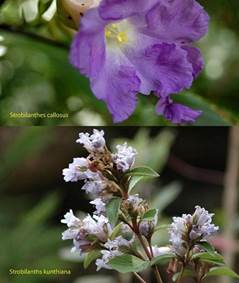Description

The Karvy (top) and the Neelakurinji (bottom)
Copyright infringement not intended
Context:
Social media in India has been awash since the past three days with photos of a ‘Neelakurinji’ bloom in the Bababudangiri range of the Western Ghats in Karnataka’s Chikkamagaluru district.

Details:
- The Neelakurinji is a shrub of the Acanthaceae family that famously blooms once every 12 years.
- Researchers who work in the Western Ghats were of the view that while some of the photos did show Neelakurinji flowers, others showed the Topli Karvy, another shrub of the Acanthaceae
- Strobilanthesis a genus of about 350 species of flowering plants in the family Acanthaceae, mostly native to tropical Asia and Madagascar.
- The Topli Karvy (Strobilanthes sessilis), the Karvy (Strobilanthes callosa) and the Kurinji (Strobilanthes kunthiana), all belong to the Strobilanthesgenus
- The external resemblance of these flowers being taxonomically related, is very similar. People can often get confused.
- The Topli Karvyis found more in the northern section of the Western Ghats in Maharashtra. It is called so since it resembles and inverted basket
- The Karvy(Strobilanthes callosa) grows on the steepest cliffs where trees can’t grow.
- The Topli Karvygrows on the plateaus of the northern Western Ghats on the other hand.
- The Neelakurinji on the other hand grows in the shola grasslands of the southern Western Ghats, which are not found in Maharashtra
- Neelakurinji was endemic to the southern Western Ghats and higher reaches of the Eastern Ghats.
- The shola forests are patches of stunted tropical montane forests surrounded by grasslands in the high elevations of southern India spread over the states of Kerala, Karnataka and Tamil Nadu.
- These shrubs expend a lot of energy to flower once in 12 years (or in the case of the Topli Karvyonce in 11 years). These shrubs die after that.
- The shola forests and grasslands were facing grave threats at the moment largely from anthropogenic activity as well as invasive species and climate change
- Be it any of these shrubs, they are very important for pollinators such as honey bees.
https://www.downtoearth.org.in/news/wildlife-biodiversity/fact-check-is-it-really-neelakurinji-that-is-blooming-in-chikkamagaluru-85158












